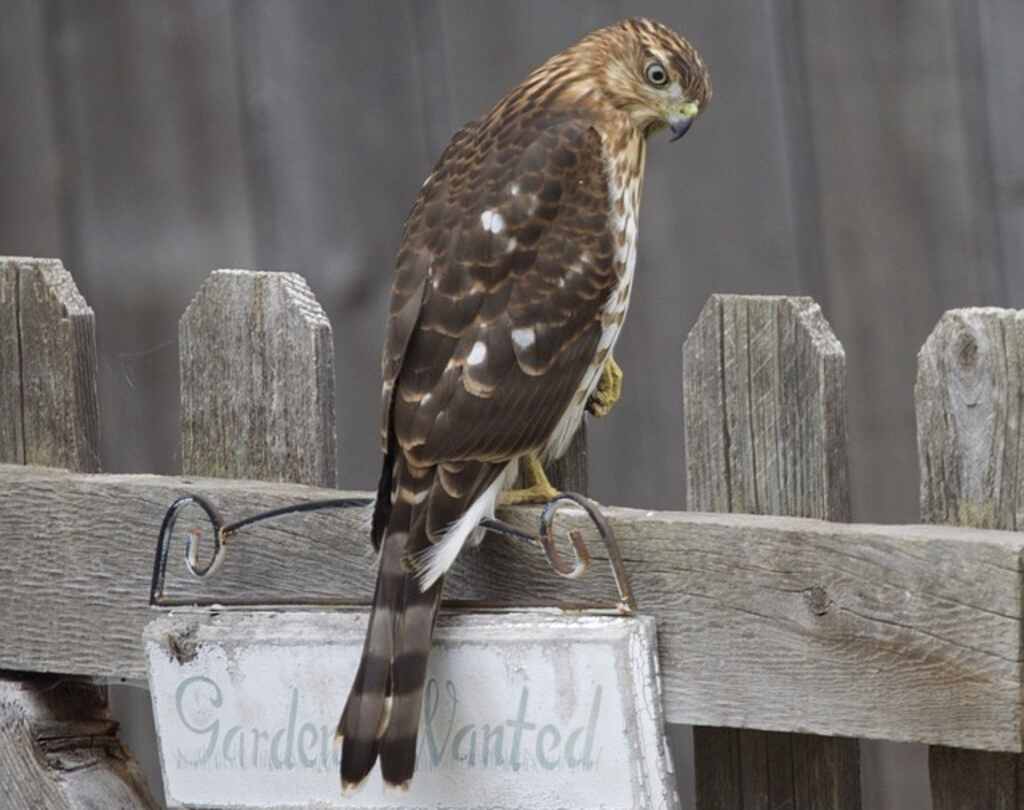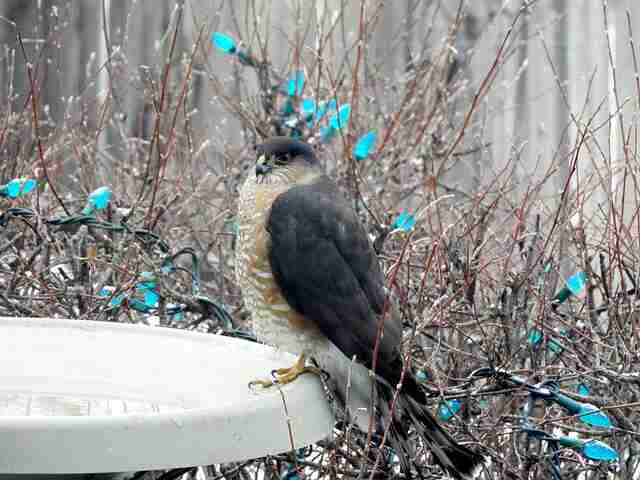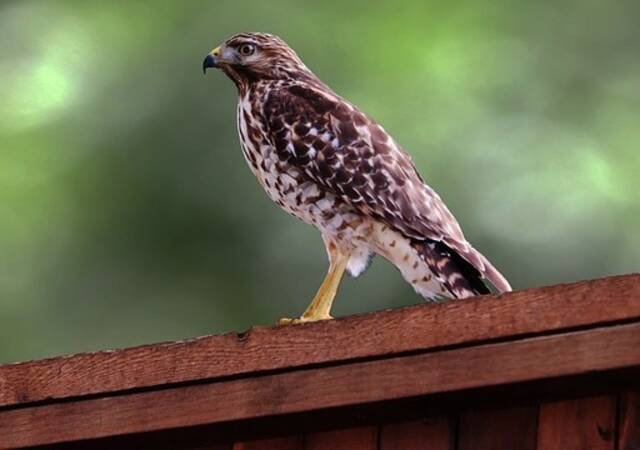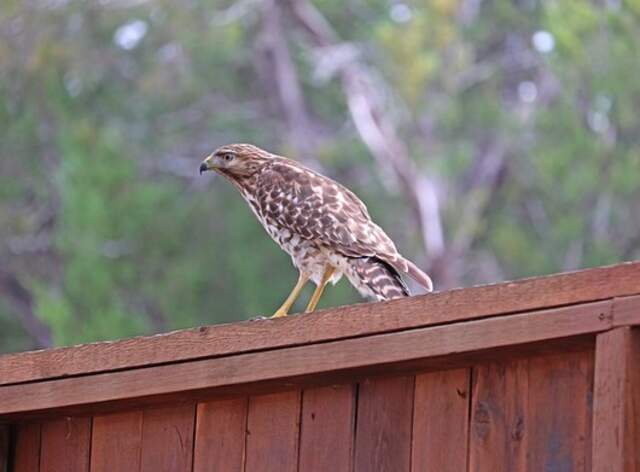For bird enthusiasts and gardeners alike, ensuring the safety of backyard birds from hawks is crucial. Hawks, though majestic, can pose a threat to smaller avian species frequenting feeders and gardens. Discover practical tips and strategies to protect your feathered visitors and maintain a harmonious backyard ecosystem.
Table of Contents
- 1 How to Deter Hawks from Backyard Birds?
- 2 Understanding Hawks and Their Behavior
- 3 Physical Deterrents
- 4 Hawk Decoys and Silhouettes
- 5 Habitat Modification
- 6 Non-Lethal Control Methods
- 7 Conclusion
- 8 Frequently Asked Questions
- 8.1 How do I know if a hawk is a problem in my backyard?
- 8.2 Are all hawks a problem for backyard birds?
- 8.3 Are physical deterrents like netting and decoys effective in deterring hawks?
- 8.4 Are sound deterrents disruptive to humans and other animals?
- 8.5 Can I discourage hawks from hunting in my backyard without hurting them?
- 8.6 Are there any plants I can add to my backyard that will discourage hawks from hunting?
- 8.7 Will using sound deterrents harm the hawks?
- 8.8 How often should I use sound deterrents?
- 8.9 Will using a hawk decoy or silhouette be enough to deter hawks?
- 8.10 Can I use any reflective material for deterring hawks?
- 8.11 How long does it take for the deterrents to work?
- 9 Author
How to Deter Hawks from Backyard Birds?
Importance of Deterring Hawks from Backyard Birds
Birds are a beloved backyard addition for many homeowners, but hawks can pose a serious threat to smaller birds. Hawks are natural predators and will often target backyard bird feeders as a reliable source of food. Deterring hawks from your backyard birds is important not only for the safety of your feathered friends, but also for the enjoyment of watching them.
Overview of Common Hawk Deterrent Methods
When it comes to deterring hawks from backyard birds, there are various methods that can be utilized. Physical deterrents such as scarecrows or wind-activated devices make use of sound, movement, and visual stimuli to frighten away the hawks.
Habitat modification is another option, which involves changing the environment to make it less attractive to predators while still providing a safe habitat for birds.
Non-lethal control methods include using decoys or fake nests, or even deploying trained falcons or kites against the hawks. Each of these methods can be effective in certain circumstances so it’s important to evaluate the advantages and disadvantages of each before deciding on one.
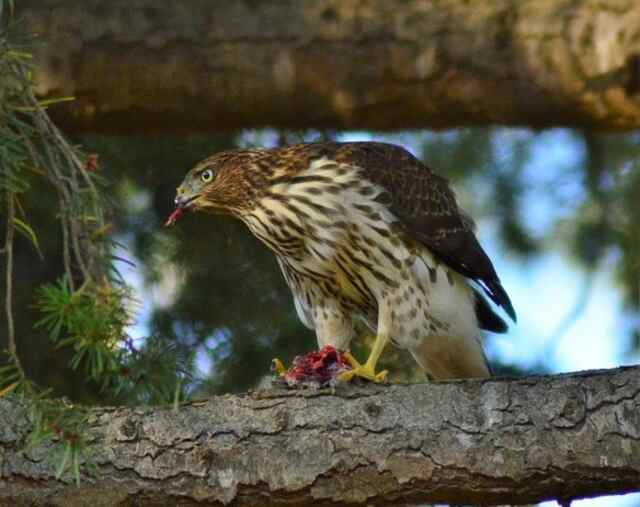
Understanding Hawks and Their Behavior
Types of Hawks Commonly Found in Backyard Settings
- Red-tailed hawk: The Red-tailed Hawk is an impressive sight to behold in any backyard. These large birds of prey are easily recognizable due to their rusty red tails and broad wingspan. They feed mainly on small mammals, birds, reptiles, and insects that they hunt from either soaring in the sky or perched atop a tree. Red-tailed Hawks are also considered quite intelligent, as they have been known to outwit crows and larger hawks for food. Seeing one of these magnificent hunters in your backyard can be a thrilling experience!
- Cooper’s hawk: Cooper’s hawks are a common sight in backyard settings, particularly in wooded areas. Known for their slender bodies and long tails, males boast more vibrant plumage than females. These birds of prey are true aerial predators, capable of reaching speeds of up to 40 mph in flight. Their hunting skills are highly developed, with a preference for smaller birds such as finches, sparrows, and doves. Their method of attack is typically a surprise, either pouncing from behind or swooping down to snatch prey from branches or midair. With its agility, speed, sharp talons and beak, the Cooper’s hawk is an impressive predator that many birdwatchers enjoy spotting in their own backyards.
- Sharp-shinned hawk: The sharp-shinned hawk is one of the most common backyard birds of prey. They are small, agile, and fast flyers that can easily navigate through trees looking for smaller birds to feed on. These hawks often target finches, sparrows, doves, and other small birds in residential gardens and backyards. As such, they are a constant reminder of the wild right at our doorstep! Nevertheless, their presence is an indicator of a healthy local ecosystem and should be welcomed by bird enthusiasts everywhere.
Hawk Hunting Behaviors and Patterns
- Diurnal hunting: Hawks that hunt during the day are known as diurnal hunters. These birds of prey prefer to be active during daylight hours, usually starting to hunt as early as sunrise or as late as sunset. They can be seen soaring in search of small prey like birds, rodents and insects, then quickly swooping in and grabbing their catch with their talons. Hawks provide an excellent example of nature’s many intricacies – they are a reminder of the beautiful balance between predator and prey.
- Nocturnal hunting: Hawks that hunt at night are known as nocturnal hunters. Skilled and efficient predators, these raptors have adapted their behavior to capitalize on the advantages of hunting during darkness. Nocturnal hunting enables them to surprise their prey, while also avoiding daytime competition from other birds of prey and humans. Hawks that hunt at night are usually more successful than those who hunt during the day due to the cover of darkness. For experienced hunters, this gives them a serious edge in the field which can be seen in their remarkable success rates when hunting at night.
- Migration patterns: Hawks are incredible birds that travel impressive distances. Some migrate seasonally, meaning they move from one area to another in search of food and suitable breeding grounds. Knowing the migration patterns of hawks common in your area can help you observe their behavior and presence in your backyard.
Factors That Attract Hawks to Backyard Bird Feeders
- Availability of food: Hawks are drawn to backyard bird feeders because they provide them with a steady source of food. The presence of other birds at the feeder also serves as an indicator that there is plenty of food available, and hawks will swoop in to take advantage. Feeders provide the perfect opportunity for hawks to hunt without having to expend too much energy. Feeders are a great way for people to observe these powerful birds up close!
- Lack of natural predators: Hawks are often seen in backyards near bird feeders, and one of the reasons for this is that there are fewer natural predators in suburban and urban areas. This means they have a better chance at successfully hunting and finding food, making it easier for them to find meals from backyard bird feeders. It’s important to remember to keep an eye out for hawks at your own backyard bird feeder – you never know when one might make an appearance!
- Suitable nesting and roosting sites: Hawks may be drawn to backyard bird feeders because they offer a suitable nesting and roosting site. Tall trees or other tall structures can provide much needed shelter for hawks, something that many backyard bird feeders can offer. This type of setup is ideal for hawks as it provides them with a safe place to nest and roost in comfort.
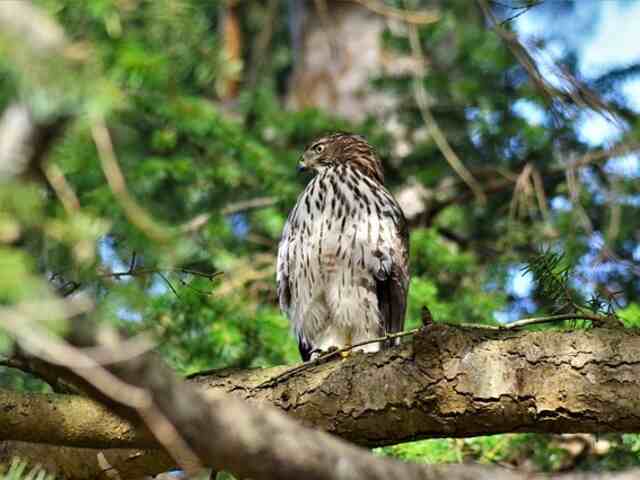
Physical Deterrents
Bird netting is a great way to keep hawks away from your backyard birds. There are several types of bird netting available, including nylon, polyethylene and PVC-coated polyester.
Each type has its own advantages and disadvantages, so make sure you choose the best one for your particular situation. Investing in bird netting can help keep your feathered friends safe from predators such as hawks.
Proper Installation and Maintenance:
Installing and maintaining the right type of netting is essential when trying to deter hawks. The height and tension of the netting should be just right in order to keep out any intruders, while regularly inspecting it for tears or damage will help ensure that it’s doing its job properly.
Additionally, take extra care to remove any debris or foliage that may have collected on top of the netting as this can become a hiding place for hawks looking for a way in. All these steps are important in keeping your property safe from unwanted predators!
Hawk Decoys and Silhouettes
Hawk decoys and silhouettes are an effective method of deterring hawks by creating the illusion of a predator in the area. These items can be bought at most garden stores and usually consist of plastic or rubber replicas of hawks, or metal or plastic silhouettes hung from poles or trees. By employing one of these physical deterrents, you can discourage hawks from entering your space safely and effectively.
Effectiveness and Proper Placement:
Decoys and silhouettes are great physical tools to deter hawks from certain areas. It’s important, however, that these be placed in the right spot – near bird feeders or other hot spots for hunting – and at the right height and angle to be seen by predators.
In addition, it’s best to move them around often so hawks don’t get used to their presence. By following this strategy you can ensure your deterrents are as effective as possible.
Reflective Tape and Shiny Objects
Reflecting light can be a powerful deterrent against hawks. Mylar tape, aluminum foil, and other shiny objects make a dazzling display that confuses and disorients the birds, making them unlikely to return. This is an easy and cost-effective way of keeping your yard or garden safe from these raptors without using any chemicals or physical barriers.
Other ideas include hanging up colorful ornaments and wind chimes that will reflect light in different directions. With careful placement, you can create an effect that will frighten away any unwelcome visitors.
Proper Placement and Maintenance:
Reflective materials are an effective way to keep hawks away from bird feeders and roosting areas. Placing them at the right height and angle ensures that they can be easily seen by hawks, while regular cleaning and maintenance keeps them shining brightly.
Additionally, it is important to move the reflective materials around regularly so that hawks do not become accustomed to their presence. By doing this, you can help ensure your birds remain safe from potential predators.
Sound Deterrents
Sound deterrents are a great way to keep hawks away from your property. Propane cannons, distress calls, and alarms can all be used to create an unpleasant noise that will deter the birds.
These devices can also be triggered manually or by motion detectors for even more convenience. Whatever device you choose, sound is an effective way to make sure these birds stay away from your property.
Effectiveness and Proper Use:
Sound deterrents are a great way to protect animals and crops from hawks, however they can be quite disruptive. It is important to use them only when necessary and in appropriate places.
Setting up the devices correctly and triggering them at the right times can maximize their effectiveness while minimizing disruption. Be sure to take precautions when using sound deterrents so that any effects are minimized.
Habitat Modification
Creating a Safe Space for Birds:
Creating a safe environment for backyard birds is one of the best ways to deter hawks from targeting them. Providing cover, nesting sites and planting native vegetation are all important steps in creating a peaceful habitat that ensures birds have places to hide and feel secure.
This natural environment can go a long way in reducing the chances of hawks targeting local bird populations. With just a few simple modifications, your backyard can become a home away from home for our feathered friends!
Providing Alternative Food Sources:
Providing alternative food sources for feeding backyard birds is an effective way to deter hawks. Berries from shrubs, mealworms, and suet are all good options as they offer a more difficult food source than what is typically available to hawks.
Not only will this help keep your feathered friends safe, but it also provides a great opportunity to observe diverse bird species coming together to feed in your own backyard!
Encouraging Natural Predators of Hawks:
Encouraging the presence of natural predators that preys on hawks, such as owls and kestrels, can be an effective way to prevent them from bothering backyard birds.
Nesting boxes for these birds can be provided to encourage their presence and adding snakes and foxes into the habitat can also help to keep the hawk population in check. This can provide a better environment and reduce the risks posed by hawks to backyard birds.
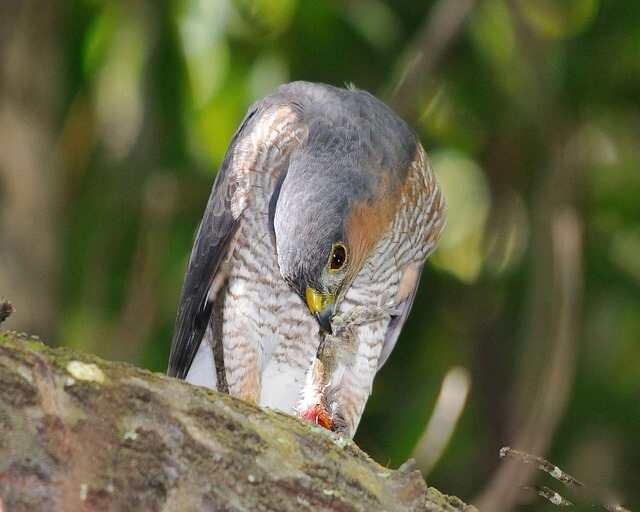
Non-Lethal Control Methods
Hazing:
Hazing is a technique used to keep hawks away from backyard birds. It is the act of making a hawk feel uncomfortable or unwelcome by using noise, harassment, and intimidation.
This can be an effective way to deter hawks from certain areas, but it should always be done humanely and responsibly. It’s important that people intervene only when absolutely necessary in order to ensure the safety of both birds and hawks alike.
Additionally, hazing should not be used as a substitute for other non-lethal control methods such as taking preventive measures or using scare tactics like kites and flags.
Training Birds to Recognize and Avoid Hawks:
Backyard birds are vulnerable to attacks from hawks, but there is a non-lethal way to help protect them. By training the birds to recognize and stay away from hawks it can be possible to reduce their risk of becoming prey.
Visual cues such as flags or scarecrows, alarm calls, and proper training techniques can all help teach backyard birds how to detect and avoid potential predators.
Through these methods, the chances of a hawk attack can be drastically reduced, greatly improving the safety of our feathered friends.
Using Repellents:
When it comes to preventing hawks from preying on backyard birds, there are a number of repellents available. These include visual deterrents like hawk decoys and silhouettes, as well as chemical repellents such as scent-based products.
To ensure the best results when using these products, be sure to read and follow all manufacturer instructions carefully. With the right strategy in place, you can protect your feathered friends without resorting to lethal methods.
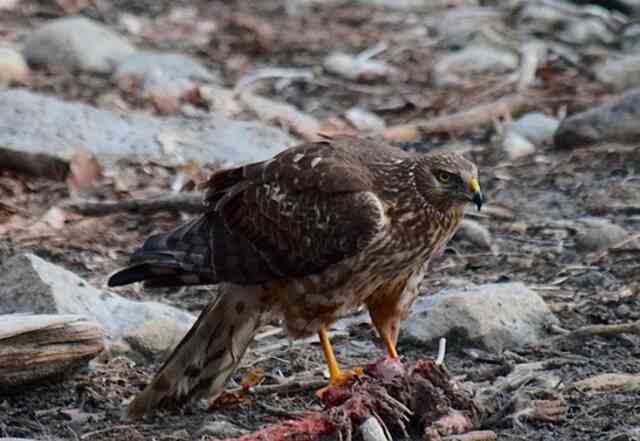
Conclusion
In conclusion, deterring hawks from your backyard birds requires a multi-faceted approach. You should provide dense shelter for the birds, place loud noises or obnoxious objects near their habitat to scare hawks away, and cover windows and other reflective surfaces that might lead to hunting attempts. Additionally, using specific bird feeders designed to keep away predators can be an effective way of keeping hawks away from your backyard birds.
Frequently Asked Questions
How do I know if a hawk is a problem in my backyard?
Having birds around your backyard is a great way to enjoy nature and watch wildlife. However, if you start to notice that birds are avoiding coming to your feeders or suddenly disappear altogether, it could be a sign of a hawk presence in the area.
Hawks usually hunt near or at feeders, so if you start to see them perched nearby, then they may be causing the sudden change in bird activity. To ensure that hawks do not become a problem, try removing any potential perching points such as trees or fences near your backyard.
Additionally, placing small bells on top of hanging feeders can help ward off any unwanted predators. Through careful observation and proactive steps, you can protect your local birds from any potential harm caused by hawks!
Are all hawks a problem for backyard birds?
Not all hawks are a problem for backyard birds. Many species, such as the red-tailed hawk and Cooper’s hawk, hunt backyard birds as prey. On the other hand, broad-winged hawks rarely cause any problems to backyard birds.
Large raptors like eagles and ospreys are also not usually a threat to birds found in backyards. Hawks like these generally feed on larger animals such as rodents or rabbits rather than small birds.
Overall, while some hawks can be a nuisance to backyard birds, they do not typically cause too much damage if their hunting activities are properly managed.
Are physical deterrents like netting and decoys effective in deterring hawks?
Physical deterrents such as netting and decoys can be an effective means of deterring hawks. However, care must be taken to ensure that they are installed and maintained properly in order to make sure they remain effective.
Additionally, these deterrents may not work if the hawks are particularly determined or if there are other attractive food sources available nearby.
Thus, physical deterrents might prove effective in deterring hawks but it is important to consider the specific situation when deciding what would be best for your particular circumstances.
Are sound deterrents disruptive to humans and other animals?
Sound deterrents can be useful tools in keeping animals away from areas where they are not wanted. However, if these devices are used improperly, or set off at the wrong times and places, they can be incredibly disruptive.
It is essential to ensure that any sound deterrents you may use are placed and activated strategically to avoid disrupting nearby people or wildlife. Additionally, it is important to remember that sound deterrents can cause hearing damage if used excessively, so care should be taken with their usage.
With appropriate setup and use of sound deterrents, areas can remain safe while minimizing disruption to local life.
Can I discourage hawks from hunting in my backyard without hurting them?
Hazing is one way to discourage hawks from hunting in your backyard. This involves using loud noises, water sprinklers, and other scare tactics to make the hawks feel unwelcome.
Training birds to recognize and avoid hawks can also be beneficial, as it will create an environment where the hawks are not seen as a food source.
Finally, repellents such as plastic owls or visual deterrents like reflective tape can be used to deter hawks from hunting in your yard.
All of these methods are non-lethal and humane alternatives for discouraging hawks from hunting in your backyard.
Are there any plants I can add to my backyard that will discourage hawks from hunting?
Adding native vegetation like bushes and shrubs to your backyard can help prevent hawks from hunting by providing them with a safe place to nest.
Berries, such as those produced by the local vegetation, offer an alternative food source that might take away hunting grounds for hawks.
Additionally, it’s possible to attract natural predators of hawks such as owls and kestrels, which could keep the hawk population at bay.
These measures taken together can provide a safer environment for backyard birds while discouraging hawks from hunting in your yard.
Will using sound deterrents harm the hawks?
Sound deterrents are a popular and efficient way to keep hawks away from people’s property. Contrary to what some may think, sound deterrents do not harm the birds in any form.
Instead, they simply use loud noises or motion to scare the hawks away so that they stay away from areas where people don’t want them.
The sound deterrents are designed with safety as their primary objective, and therefore have no adverse effects on the health of the birds exposed to them.
They are non-lethal and are only meant to scare off the hawks without causing any physical damage or harm to them whatsoever.
How often should I use sound deterrents?
When to use sound deterrents depends largely on the situation and the level of hawk activity in your area. For instance, if you have a small chicken coop in an urban setting with a lot of hawks around, you will likely need to use sound deterrents more frequently than someone living in a rural area with fewer hawks.
In any case, it is best to use sound deterrents sparingly and only when necessary, since they can be bothersome for other animals and people in the vicinity.
Regular checks and preventive measures such as proper fencing are also great ways to keep birds of prey away from your chickens.
Will using a hawk decoy or silhouette be enough to deter hawks?
Hawks can be deterred with the use of a decoy or silhouette, but it must be used in combination with other methods. For example, changing the habitat to make it less inviting to hawks and physically blocking them from entering an area can be effective.
While a hawk decoy or silhouette can help create an illusion that another bird is already occupying that space, this technique should not be relied upon as the sole deterrent on its own.
The use of other methods in conjunction with the decoy or silhouette offers more holistic protection against hawks.
Can I use any reflective material for deterring hawks?
When it comes to deterring hawks, not all reflective materials are created equal. To be most effective, you should use materials specifically designed to repel hawks, such as shiny Mylar strips or reflective tape.
These materials will reflect sunlight in ways that confuse and disorient hawks and cause them to fly away from the area they’re trying to approach.
Additionally, you can also place 3D models of predators like owls in your space – these give the false impression of an actual threat, which may convince hawks not to stay near your property.
Finally, loud recordings of hawk calls can also help scare off unwelcome birds.
How long does it take for the deterrents to work?
The length of time it takes for deterrents to work depends on the type of deterrents used, and how active the hawk is in your area. In most cases, it may take several weeks or even months for deterrents to become fully effective.
To ensure success, you must have a lot of patience and stay persistent with your effort to deter hawks from your space. It is also important to remember that different methods may be more or less effective depending on the species of hawk active in your area.
Different birds respond better to different types of deterrence, so experimenting can help you find the best solution for your particular situation.
Related Post: Can A Hawk Pick Up A Dog? (What You Need To Know)

